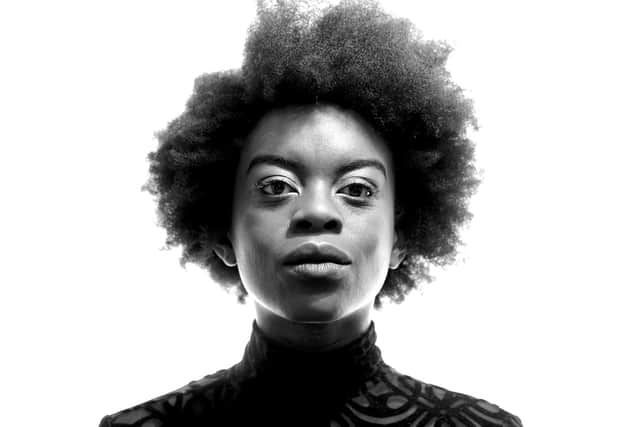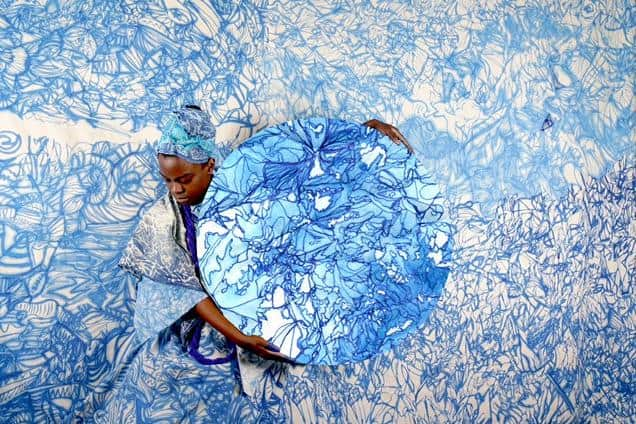Ones to watch in 2021: Sekai Machache, artist


When talking about the past year, Sekai Machache keeps coming back to the word “intense.” Intense to find herself confined to her flat after plans for exhibitions and residencies were cancelled by the pandemic. Intense when Black Lives Matter protests erupted around the world and she was invited to speak out as a black Scottish artist. Intense when her own work for the Black Lives Matter Mural Trail was vandalised and she became the focus of media attention.
Now, with postponed projects rescheduled for 2021 and some new ones to boot, it looks like the year ahead could be even more intense. Machache’s latest project, The Divine Sky, will be premiered across three exhibitions at Stills, House for an Art Lover (during Glasgow International) and the RSA (as the recipient of the 2020 Morton Award). A show at Street Level Photoworks offers a long awaited opportunity to show Body of Land, made with Kenyan artist Awuor Onyango, and she has been selected for the Talbot Rice Gallery’s two-year residency programme for emerging artists starting in January. “I’m really excited,” she says, “but also a bit overwhelmed.”
Advertisement
Hide AdBorn in Zimbabwe and raised in Glasgow, Machache, 31, lived in Dundee for 12 years and has just relocated to Edinburgh (“an insane thing to do during a pandemic!”). She is principally known for her work in photography: figurative images shot in low light, often using herself as model. The Divine Sky project will showcase other aspects of her practice include performance, textiles and (after making her first film in lockdown) film-making.


As an artist of colour, she is used to having conversations about race, but its place in her work is complex. At art school in Dundee, she had no intention of making work about race at all. “I was interested in lucid dreaming, because I’ve always had a lot of issues around sleep. I focused in on the hypnagogic state, which is the state between sleeping and waking which fascinated the Surrealists and the early psychoanalysts like Freud and Jung.
“I was making images that reflected that, and when I had a white model in my work, people always understood that it was about dreams and sleep issues and insomnia – they totally got it. But when I put myself in the work, immediately people misconstrued the work as being about race. I was feeling at a loss as to how to make work with a black figure in it without that misconception.”
That experience began a journey of discovery about the “white gaze,” and a renegotiation of her approach. Inspired by the black American artist Kerry James Marshall, who made a decision early on to use only black subjects in his paintings, she decided to use only black models – mainly, in the first instance, herself (“I was the only black woman I knew!”). She says she took photographs of herself as a teenager, long before selfies became fashionable, and an art teacher gave her a book about Cindy Sherman and encouraged her to see her work as art.
An important body of photographs, Invocation, which was shown in Sao Paolo, Brazil, in 2018, explored ideas around the perceptions of black women and the Hindu goddess Kali. “Kali’s image is always considered to be terrifying, intense, even evil. I was using her image to show that representations of black women in popular culture and media tend to be of that nature, to make us seem harsh, aggressive, angry and strong. I wanted to soften that image and show a sense of vulnerability but also a power within that vulnerability.
“My work is about spirituality and illusions and perception and liminality, as much as it’s about the representation of black figures. It’s both of those things at once.”
Advertisement
Hide AdMachache made what is possibly her most political work to date when she was invited to take part in the Scottish Black Lives Matter Mural Trail in Dundee. Her large-scale photographs of black people wearing African print face masks were shown on hoardings at Slessor Park in the city. The series, called “a BREAdTH apart” linked the last words of George Floyd (“I can’t breathe”) with the disproportionate risks posed by Covid-19 for people of colour (public health data suggests people of ethnic minorities are between 10 and 50 per cent more likely to die from the virus).
“I was trying to bring forward ideas about the visibility of black people in Scotland, and about our vulnerability to Covid-19,” she says. “It’s important to understand the ways in which systemic anti-blackness affects quality of life, access to adequate healthcare and life expectancy for black people.” Shortly after it was put up, the work was extensively vandalised, and Machache found herself again speaking to the media about race. In an outpouring of support, local people gave money to the Mural Trail’s Go Fund Me page to have the posters reprinted and rehung.
Advertisement
Hide AdMachache’s new work delves into African history, spirituality and rituals. The Divine Sky addresses “complicated history” through an investigation into the traditional indigo dyeing practices of West Africa. “Wearable pieces” made from fabric Machache has dyed herself will be used to make performances in the Scottish landscape, as soon as lockdown eases. She describes the project as “giving me space to create, in all of the different ways I like to create and would like to be able to develop.”
Body of Land, made after a residency in Kenya in 2018, is rooted in research into the spirituality of pre-colonial Africa, including her own ancestors, the Shona people of Zimbabwe. It has brought her full circle, back to the subject of dreams; part of the work was inspired by her own lucid dreaming.
“When I was doing my (early) work on lucid dreaming, I didn’t realise I was actually participating in my heritage. It’s something that’s really significant in Shona culture. People who do dream work are considered to be ‘gifted’, and tend to be healers or diviners. It’s been really important – I felt like I’d figured something out without having anyone telling me. I’m looking at the messages you can receive from your ancestors in your dreams and the rituals you can create through listening to them.”
And, in another significant shift, she uses friends from Yon Afro Collective (of which she is a founder member) as models, as well as herself. She laughs. “I do pop up in my work still, but not as much!”
*In 2021 Sekai Machache will show work at Stills, Edinburgh, from 11 May until 12 June; at Street Level Photoworks, Glasgow, (with Awuor Onyango), from 12 June until 1 August, and House for an Art Lover, Glasgow, (with Thulani Rachia), from 11-27 June (both part of Glasgow International); and also at the Royal Scottish Academy and as part of the Edwin Morgan Centenary Project, dates to be confirmed.
A message from the Editor:
Thank you for reading this story on our website. While I have your attention, I also have an important request to make of you.
Advertisement
Hide AdThe dramatic events of 2020 are having a major impact on many of our advertisers - and consequently the revenue we receive. We are now more reliant than ever on you taking out a digital subscription to support our journalism.
To subscribe to scotsman.com and enjoy unlimited access to Scottish news and information online and on our app, visit https://www.scotsman.com/subscriptions
Joy Yates, Editorial Director